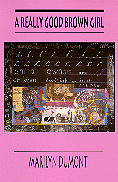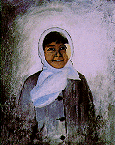


|
A Really Good Brown Girl.
Marilyn Dumont. Subject Heading:
Grades 9 - 12 / Ages 14 - 17. **** /4
|

 The discrimination experienced by the aboriginal people in Canada is a blot on our history. Even though our society is supposedly enlightened, institutionalized subjugation takes many, many generations to overcome. Our educational system acknowledges it and teaches students that the rights of Canada's first peoples were, and are, violated. However, learning about it and living it are different matters. While most immigrant groups have experienced discrimination on the basis of colour or religion, the passing of generations has generally blended them into the mix. Not so with the aboriginal people of Canada.
The discrimination experienced by the aboriginal people in Canada is a blot on our history. Even though our society is supposedly enlightened, institutionalized subjugation takes many, many generations to overcome. Our educational system acknowledges it and teaches students that the rights of Canada's first peoples were, and are, violated. However, learning about it and living it are different matters. While most immigrant groups have experienced discrimination on the basis of colour or religion, the passing of generations has generally blended them into the mix. Not so with the aboriginal people of Canada.
In A Really Good Brown Girl, Marilyn Dumont writes about the reality of being a Metis in Canadian society.The book is divided into four sections: "Squaw Poems," "What More Than Dance," "White Noise" and "Made of Water." The cover art reflects the conflicting and overlapping aspects of Metis life - the aboriginal heritage, the attempts at white identity, the schooling in English and Cree, aboriginal spirituality, and more.
In The Red and White she writes about the continual efforts made by "do-gooders" to make brown children into white children:
god knows Mary tried
to keep us clean and fed, respectable but
all the bleach and soup bones
in the Red & White couldn't keep our
halfbreed hides from showing through
In Memoirs of a Really Good Brown Girl, she talks about the dual life she lived, keeping her aboriginal and white worlds separate, and how she adapted herself to fit in and be accepted in white society until she proclaimed her heritage as an adult. The poems in "What More Than Dance" and "White Noise" talk about her life in the white world, and her awakening identity. Breakfast of the Spirit evokes the feelings that gripped her entire being:
familiar as the ripple in your throat
waiting for your voice to return
from the sealed-off jars of memory
released now to feast on the preserves
after you've slept so long
tasted now, at the celebratory breakfast of your awakening.
In the final section, "Made of Water," Dumont deals with the relationships within her family. They are tender poems that reflect Dumont's maturity and desire to find answers and bring a sense of closure to unresolved problems of the past, as in He Taught Me:
he would never have suspected
that I'd find my way back
through clear cuts, slash and burn,
along right-of-ways, cut-lines, nerve-endings,
longitude and latitude,
along arteries, over skin plains,
and valleys of hair,
topographical features of flesh,
after surveying,
calibrating the fault lines.he never would have guessed
that I'd become a forester of my own flesh.
Dumont's poems are rich with symbolism, and are at the same time very direct and bold. She deals with all the issues - the limitations placed on her by white society and by rivalries within aboriginal society. She is honest and direct, and yet also displays keen powers of observation and a sense of humour. Dumont is the author of five other anthologies of poems, and is a writer whose work is well worth reading. This book would provoke vigorous discussion and thought in any language arts program, and provides aboriginal or Metis students a poet with whom they can identify. A Really Good Brown Girl offers students not only well-written poems to study, but an analysis of Canadian society that must be addressed.
Highly recommended.
Harriet Zaidman is a teacher-librarian in Winnipeg.

To comment on this title or this review, send mail to cm@umanitoba.ca.
Copyright © 1997 the Manitoba Library Association. Reproduction for personal use is permitted only if this copyright notice is maintained. Any other reproduction is prohibited without permission.
Published by
The Manitoba Library Association
ISSN 1201-9364
AUTHORS |
TITLES |
MEDIA REVIEWS |
BOOKSHELF
BACK ISSUES |
SEARCH |
HOME